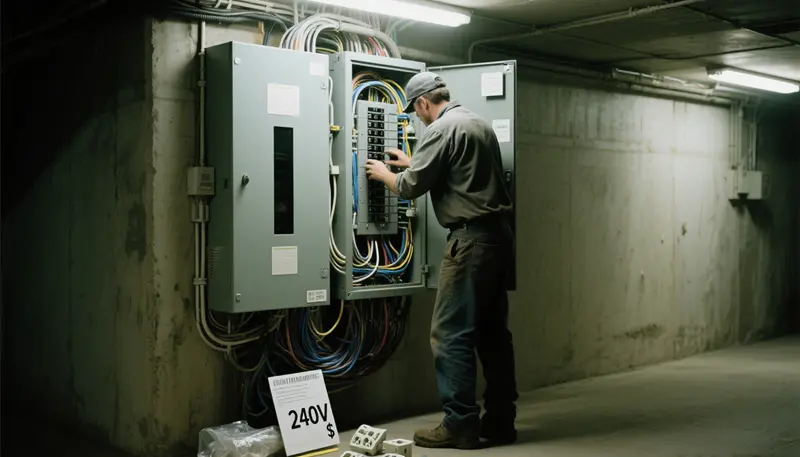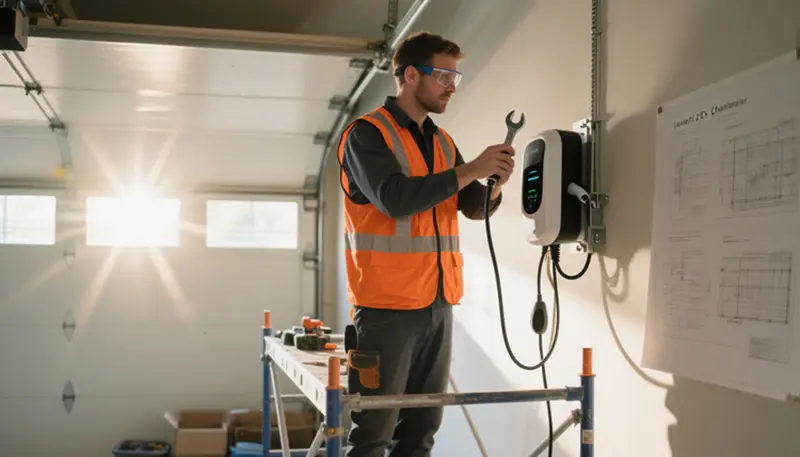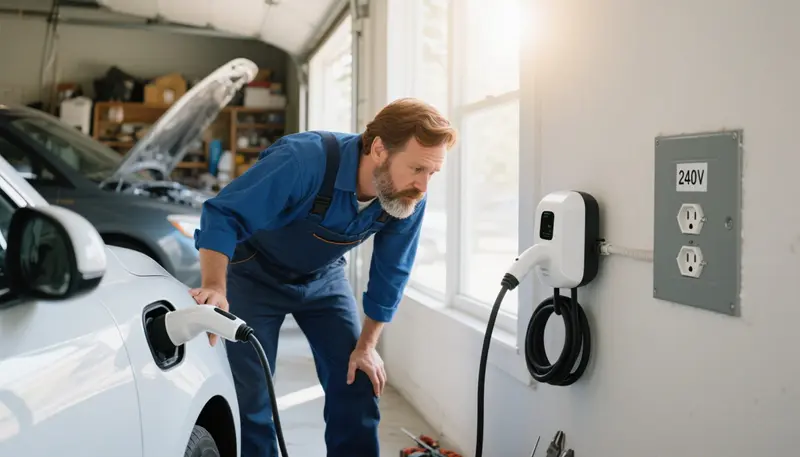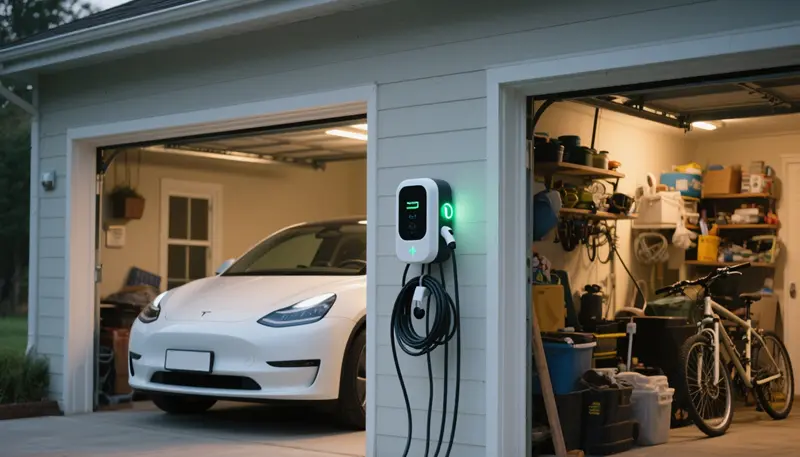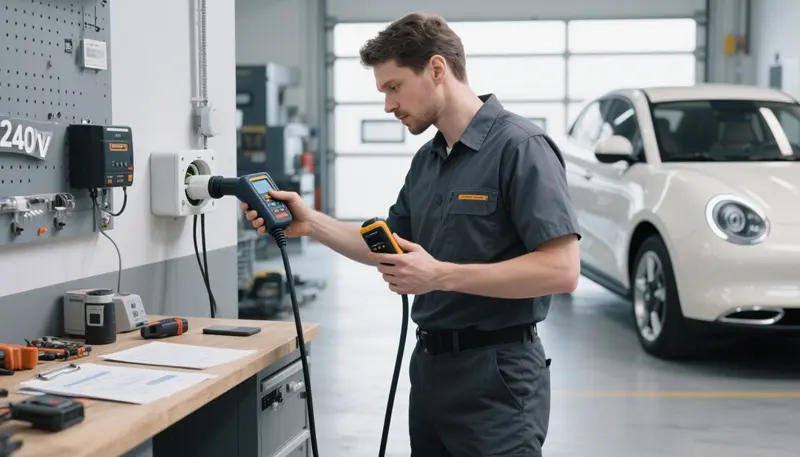Blog
How Much Does It Cost to Install a 240V Outlet for Your Home?
Introduction: Understanding the Cost to Install a 240V Outlet
As electric vehicles (EVs), high-powered appliances, and home workshops become more common, many homeowners are asking, how much does it cost to install a 240V outlet? Whether you’re planning to charge a Tesla, power a dryer, or equip a garage workshop, a 240V outlet is a versatile and essential upgrade. This comprehensive guide explores the cost to install a 240V outlet, including factors like 240V outlet in a garage, 240 volt installation, and how to install a 240V outlet. We’ll answer key questions such as how much to install a 240V outlet in a garage, how to add a 240V outlet, and what’s the average cost to install a 240V outlet, providing actionable insights for U.S. and European homeowners.
With detailed cost breakdowns, installation steps, and expert tips, this article will help you navigate the process of installing a 240 volt outlet, whether it’s for an EV charger or another high-power need. Let’s dive into the cost to install a 240V outlet and everything you need to know to make an informed decision.
Why Do You Need a 240V Outlet in Your Home?
Why Should I Consider Adding a 240V Outlet?
A 240V outlet delivers twice the voltage of a standard 120V outlet, making it ideal for high-power applications. Here’s why homeowners are opting to add a 240 volt outlet:
- Electric Vehicle Charging: A 240V outlet powers Level 2 EV chargers, delivering 20-50 miles of range per hour for vehicles like Tesla, Nissan Leaf, or Ford Mustang Mach-E, compared to 3-5 miles with a 120V outlet.
- Large Appliances: Dryers, ovens, and air conditioners often require 240 volt installation for efficient operation.
- Home Workshops: Power tools like welders, compressors, or table saws benefit from a 240V outlet in a garage, providing consistent performance.
- Energy Efficiency: Higher voltage reduces energy loss, making installing a 240 volt outlet cost-effective for heavy loads.
Why Install a 240V Outlet in a Garage?
The garage is a popular choice for 240V outlet in a garage installations due to:
- Proximity to Electrical Panel: Most home panels are located in or near the garage, reducing wiring costs for installing a 240 volt outlet in a garage.
- Convenience for EV Charging: Parking your EV in the garage makes plugging into a 240V outlet easy and secure.
- Versatility: A 240V outlet in a garage supports both EV charging and workshop tools, enhancing functionality.
Adding a 240V outlet to your home, especially in the garage, is a practical investment that boosts convenience and property value, particularly in EV-heavy markets like California or Norway.
How Much Does It Cost to Install a 240V Outlet?
What Is the Average Cost to Install a 240V Outlet?
The cost to install a 240V outlet varies based on factors like location, electrical system, and labor rates. Here’s a detailed breakdown:
1.Equipment Costs:
- Outlet: A 240V outlet (e.g., NEMA 14-50 or 6-50) costs $10-$50.
- Breaker: A 40-50 amp double-pole breaker costs $20-$50.
- Wiring and Conduit: 6 AWG copper or 4 AWG aluminum wiring, plus conduit for safety, costs $50-$200, depending on distance.
- Mounting Hardware: Outlet boxes and accessories add $10-$50.
Total Equipment Cost: $50-$200.
2.Labor Costs:
- Electrician Fees: A licensed electrician charges $50-$150 per hour in the U.S. or €40-€100 in Europe. Electrician install 240V outlet typically takes 2-4 hours for simple setups or 6-8 hours for complex ones.
- Regional Variations: Urban areas (e.g., San Francisco, London) have higher rates ($100-$150/hour) than rural areas ($50-$80/hour).
Total Labor Cost: $300-$800.
3.Electrical Upgrades:
- Panel Upgrade: If your panel (e.g., 100 amps) lacks capacity for a 40-50 amp circuit, upgrading to 200 amps costs $1,000-$3,000.
- Subpanel Installation: A subpanel for distant outlets costs $500-$1,500.
- Service Upgrade: Upgrading a transformer or service line (rare) adds $2,000-$5,000.
Total Upgrade Cost: $0-$3,000 (if needed).
4.Permits and Fees:
- Permits: Most jurisdictions require permits for 240 volt installation, costing $50-$200.
- Inspection Fees: Post-installation inspections may add $50-$150.
Total Permit Cost: $50-$200.
Total Cost Range
- Basic Installation: $400-$800 (outlet near panel, no upgrades).
- Average Installation: $800-$2,000 (moderate wiring, standard labor).
- Complex Installation: $2,000-$5,000 (panel upgrades, long wiring runs).
Specific Costs for Garage Installations
The cost to install a 240V outlet in a garage is often lower than other locations due to proximity to the electrical panel:
- Simple Garage Setup: $400-$1,000 (outlet within 10-20 feet of panel).
- Complex Garage Setup: $1,000-$2,500 (longer wiring runs or panel upgrades).
Regional Variations
- U.S.: How much to install a 240V outlet ranges from $800-$2,000 in urban areas (e.g., California, New York) and $400-$1,000 in rural regions (e.g., Midwest).
- Europe: 240V installation cost ranges from €500-€2,000, with higher rates in Germany (€1,000-€2,500) and lower in Eastern Europe (€500-€1,500).
The average cost to install a 240V outlet typically falls between $800-$2,000, with garage installations often at the lower end due to easier access to the panel.
How to Install a 240V Outlet Safely?
How to Add a 240V Outlet or Install a 240V Outlet in a Garage?
Installing a 240V outlet requires professional expertise to ensure safety and compliance with electrical codes. Here’s a step-by-step guide for how to install a 240V outlet or how to install a 240V outlet in a garage:
Assess Your Electrical System:
- Check panel capacity (100-200 amps) to support a 40-50 amp circuit for 240 volt installation.
- Conduct a load calculation to avoid overloading other appliances.
- Identify the outlet location, ideally near the panel for a 240V outlet in a garage to minimize costs.
Choose the Outlet Type:
- NEMA 14-50: Four-prong outlet (hot, hot, neutral, ground), common for EV chargers like Tesla’s Mobile Connector. Costs $10-$30.
- NEMA 6-50: Three-prong outlet (hot, hot, ground), used for welders or some EV chargers. Costs $10-$25.
- Ensure compatibility with your device (e.g., EV charger, appliance).
Hire a Licensed Electrician:
- Why Professional Installation?Electrician install 240V outlet ensures compliance with the National Electrical Code (NEC) Article 625 or European IEC standards, preventing risks like fire or electrocution. DIY is strongly discouraged.
- Find electricians via platforms like Angi, HomeAdvisor, or manufacturer directories (e.g., Tesla’s certified installers).
Obtain Permits:
- Most jurisdictions require permits for installing a 240 volt outlet, costing $50-$200.
- Your electrician submits plans to the local building department, ensuring compliance with safety codes.
- Learn more about 👉“How to Apply for a Permit to Install an EV Charger”
Installation Process:
- Wiring: Run 6 AWG copper or 4 AWG aluminum wiring from the panel to the outlet, using conduit for exposed or outdoor runs.
- Breaker: Install a 40-50 amp double-pole breaker in the panel.
- Outlet Mounting: Secure the outlet in a weatherproof box (e.g., NEMA 3R for garages with moisture exposure).
- Testing: Verify the outlet delivers 240 volts and functions correctly.
Final Inspection:
- A local inspector checks the 240 volt installation for code compliance, ensuring proper grounding and safety.
- Once approved, the outlet is ready for use.
Specifics for Garage Installations
For how to install a 240V outlet in a garage:
- Location: Mount the outlet near the parking spot or workshop area, 3-5 feet above the floor for accessibility.
- Cable Management: Use hooks or reels to keep EV charger cables tidy, preventing tripping hazards.
- Ventilation: Ensure adequate airflow to prevent overheating, especially for EV chargers.
The process for how to put in a 240V outlet typically takes 2-8 hours, with installing a 240 volt outlet in a garage often quicker due to panel proximity.
What Factors Affect the Cost to Install a 240V Outlet?
What Drives the Cost to Install a 240V Outlet in a Garage or Elsewhere?
Several factors influence the 240V installation cost:
1.Electrical Panel Capacity:
- Older Homes: 100-amp panels may require upgrading to 200 amps ($1,000-$3,000) to support a 240V outlet.
- Modern Homes: 200-amp panels typically have sufficient capacity, avoiding upgrade costs.
2.Outlet Location:
- Near Panel: A 240V outlet in a garage near the panel costs $400-$800 due to minimal wiring.
- Distant Locations: Long wiring runs (e.g., across the house or to a driveway) increase costs to $1,000-$2,500.
- Garage Advantage: Cost to install a 240V outlet in a garage is often lower due to shorter wiring distances.
3.Regional Labor Rates:
- U.S.: Urban areas (e.g., Los Angeles, New York) charge $100-$150/hour, while rural areas charge $50-$80/hour.
- Europe: Germany and the UK charge €80-€120/hour, compared to €40-€60/hour in Eastern Europe.
4.Electrical Upgrades:
- Subpanel: If the main panel is full, a subpanel costs $500-$1,500.
- Service Upgrade: Upgrading from 100 to 200 amps or adding a new service line costs $2,000-$5,000.
5.Installation Environment:
- Indoor (Garage): Installing a 240 volt outlet in a garage is cheaper than outdoor setups, which require weatherproofing (e.g., NEMA 3R enclosure, $50-$100).
- Complex Structures: Older homes or multi-story buildings may require additional conduit or structural modifications.
6.Permitting and Code Requirements:
- Stricter codes in some areas (e.g., California’s Title 24) may increase cost to install a 240V outlet due to additional safety features like GFCI breakers ($50-$100).
Cost-Saving Tips
- Choose a Nearby Location: Opt for a 240V outlet in a garage close to the panel to minimize wiring costs.
- Compare Electrician Quotes: Get 3-5 quotes for electrician install 240V outlet to ensure competitive pricing.
- Leverage Incentives: Check for rebates or tax credits to offset 240V installation cost (see below).
- Future-Proof: Install a 50-amp circuit to support higher-power devices or future EVs, avoiding later upgrades.
By understanding these factors, you can better estimate how much to install a 240V outlet and plan a cost-effective 240 volt installation.
Do You Need a Permit to Install a 240V Outlet?
Is a Permit Required for Installing a 240 Volt Outlet?
Yes, most jurisdictions require a permit for installing a 240 volt outlet to ensure compliance with electrical codes like NEC Article 625 (U.S.) or IEC standards (Europe). Permits typically cost $50-$200 and are handled by your electrician. Here’s why permits matter:
- Safety: Permits ensure the 240V outlet is properly wired, grounded, and safe, reducing risks of fire or shock.
- Compliance: Adheres to local building codes, preventing fines or issues during home inspections (e.g., during a sale).
- Insurance: Unpermitted work may void insurance coverage for electrical damages.
- Warranty: Some EV charger manufacturers require permitted installations to maintain warranties.
Permit Process
- Application: Your electrician submits electrical plans, including outlet type (e.g., NEMA 14-50), circuit details, and location (e.g., 240V outlet in a garage).
- Inspection: Post-installation, an inspector verifies compliance, typically within 1-5 days.
- Cost: Cost to install a 240V outlet includes permit fees ($50-$200) and inspection costs ($50-$150).
Skipping a permit for adding a 240V outlet can lead to fines ($100-$1,000) or costly corrections, so always consult your electrician to confirm local requirements.
Can You Install a 240V Outlet in a Garage?
Can I Install a 240V Outlet in a Garage for EV Charging or Tools?
Absolutely, installing a 240 volt outlet in a garage is one of the most common and practical choices for homeowners. Here’s why a 240V outlet in a garage is ideal:
- EV Charging: Supports Level 2 chargers for EVs, delivering fast, convenient charging for daily commutes.(e.g.,👉 FlagTools Home EV Charger)
- Workshop Tools: Powers heavy equipment like welders, air compressors, or saws, enhancing garage functionality.
- Cost Efficiency: Proximity to the electrical panel reduces cost to install a 240V outlet in a garage, typically $400-$1,000 for simple setups.
- Safety: Garages offer protection from weather, reducing the need for costly weatherproofing compared to outdoor installations.
Best Practices for Installing a 240V Outlet in a Garage
- Location: Mount the outlet near the parking spot (for EVs) or workbench (for tools), 3-5 feet above the floor for accessibility. This optimizes how to install a 240V outlet in a garage.
- Cable Management: Use hooks, reels, or wall-mounted organizers to keep EV charger cables tidy, preventing tripping hazards.
- Ventilation: Ensure adequate airflow to prevent overheating, especially for EV chargers generating heat.
- Safety: Comply with fire codes by keeping the outlet away from flammable materials (e.g., gasoline, paint).
The cost to install a 240V outlet in a garage ranges from $400-$2,000, depending on wiring distance and electrical upgrades, making it a cost-effective choice for most homeowners.
How to Save on 240V Outlet Installation Costs?
How Can I Reduce the Cost to Install a 240V Outlet?
Saving on the 240V installation cost is possible with strategic planning:
1.Leverage Government Incentives:
- U.S.: The Alternative Fuel Vehicle Refueling Property Credit offers up to 30% of costs (capped at $1,000 for residential installations, as of 2025) for 240V outlet installations used for EV charging.
- State Rebates: California’s CALeVIP offers $500-$1,000, while New York’s ChargeNY provides similar incentives.
- Utility Rebates: Companies like PG&E or ConEd offer rebates or off-peak rates for installing a 240 volt outlet.
- Europe: UK’s Electric Vehicle Homecharge Scheme provides up to £350, while Germany’s KfW grants offer €900 for charging infrastructure.
2.Choose a Cost-Effective Location:
- Opt for a 240V outlet in a garage near the electrical panel to minimize wiring costs, reducing the cost to install a 240V outlet in a garage to $400-$800.
- Avoid long wiring runs or outdoor installations requiring weatherproofing.
3.Compare Electrician Quotes:
- Request 3-5 quotes for electrician install 240V outlet to find competitive pricing.
- Check credentials and reviews to ensure quality without overpaying.
4.Use Existing Infrastructure:
- If your panel has sufficient capacity (e.g., 200 amps), avoid costly upgrades.
- For Level 1 EV charging, use an existing 120V outlet to delay adding a 240V outlet.
5.Plan for Future Needs:
- Install a 50-amp circuit to support future high-power devices, avoiding repeat installations and keeping 240V installation cost low long-term.
Long-Term Savings
- Electricity Costs: Charging EVs with a 240V outlet using off-peak rates ($0.10-$0.20/kWh) saves $100-$500 annually compared to public chargers ($0.30-$0.50/kWh).
- Property Value: A 240V outlet in a garage can increase home resale value by 1-3% in EV-heavy markets like California or Norway.
- Battery Health: Level 2 charging(e.g.,👉 FlagTools Home EV Charger) is gentler on EV batteries than DC fast charging, extending battery life.
By combining incentives and smart planning, you can significantly reduce how much to install a 240V outlet and enjoy long-term benefits.
Conclusion: Plan Your 240V Outlet Installation
Understanding how much does it cost to install a 240V outlet empowers you to plan a safe, efficient, and cost-effective upgrade for your home. Whether you’re installing a 240 volt outlet in a garage for EV charging or elsewhere for appliances, the cost to install a 240V outlet typically ranges from $400-$800, with potential upgrades pushing it to $2,000-$5,000. By choosing a strategic location like a 240V outlet in a garage, hiring a licensed electrician for electrician install 240V outlet, and leveraging incentives, you can minimize 240V installation cost while maximizing benefits.


